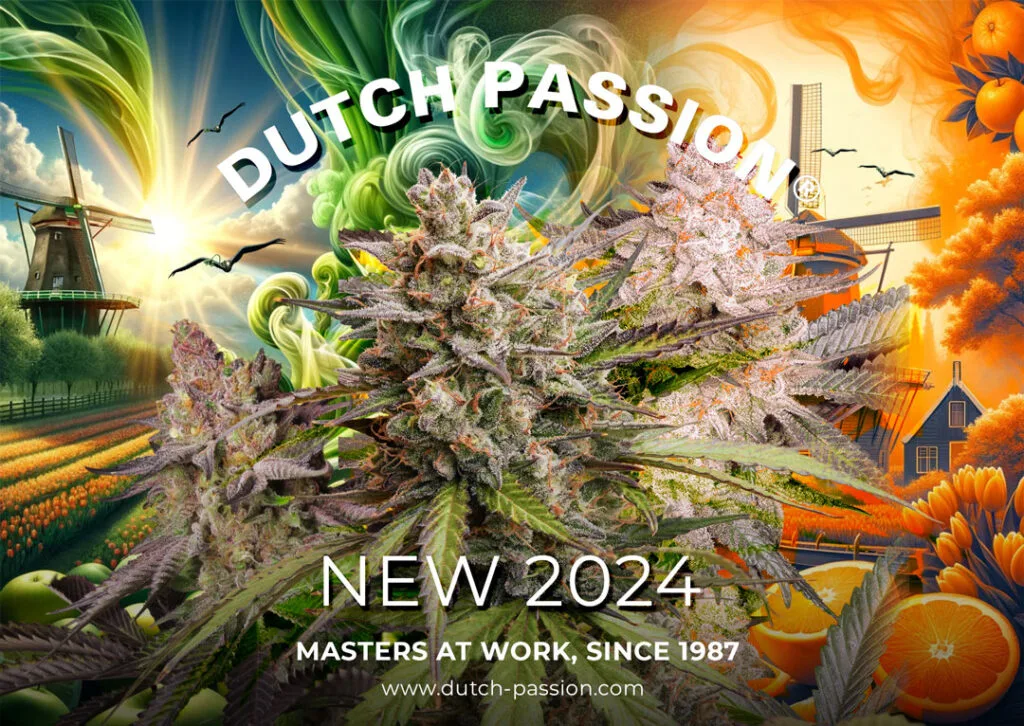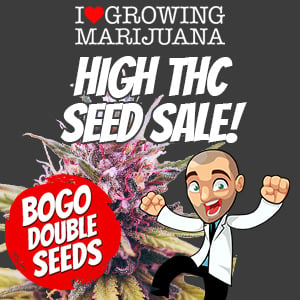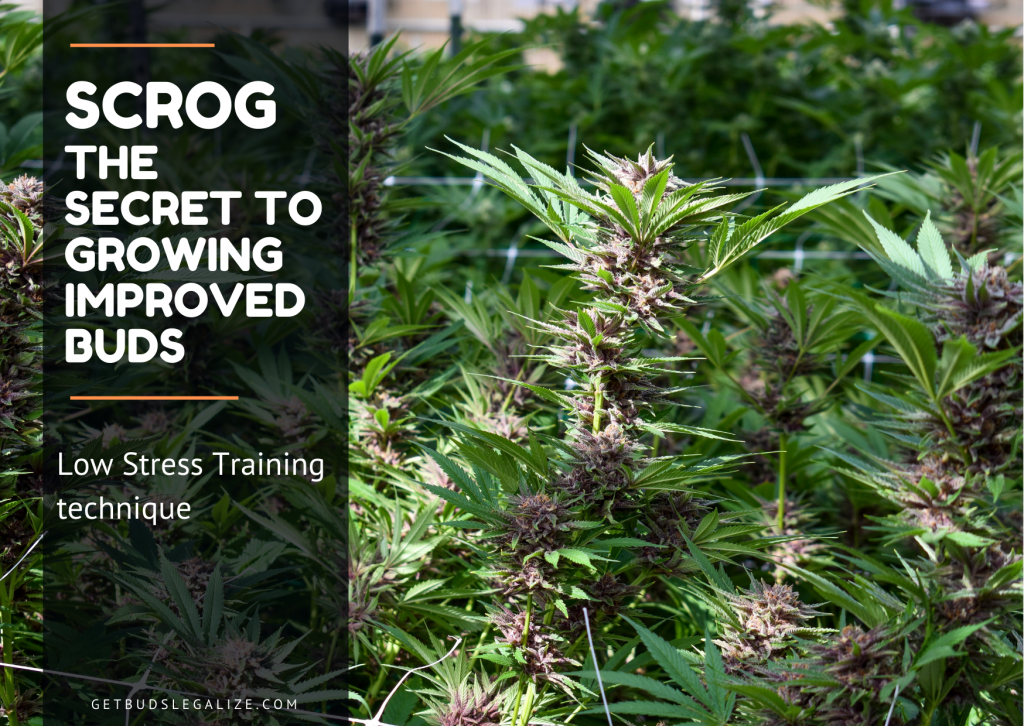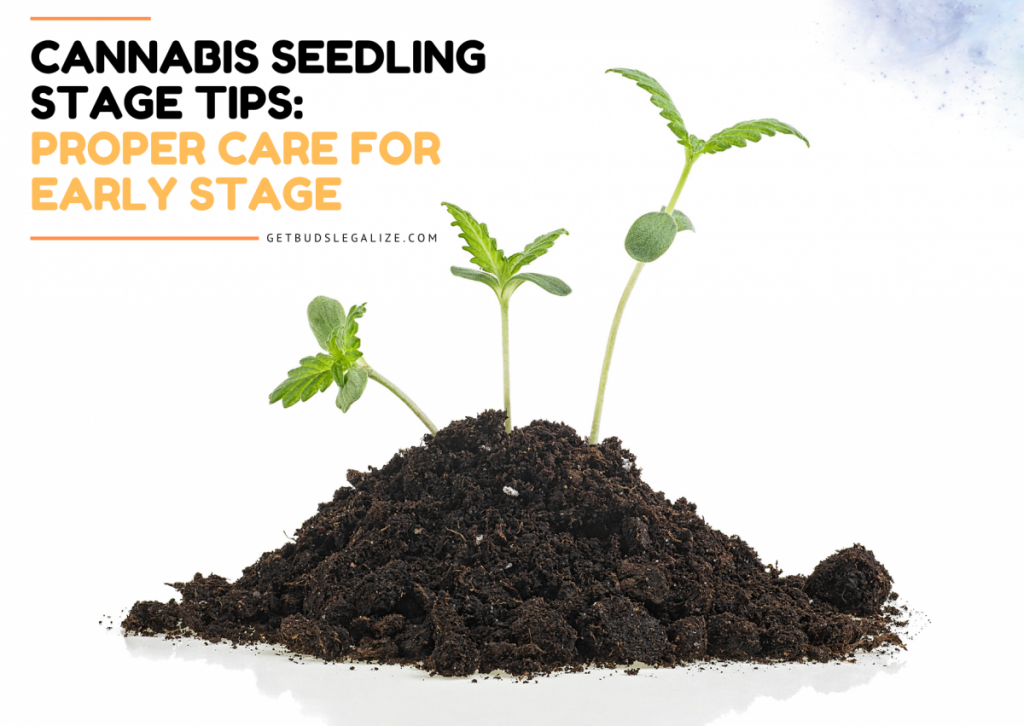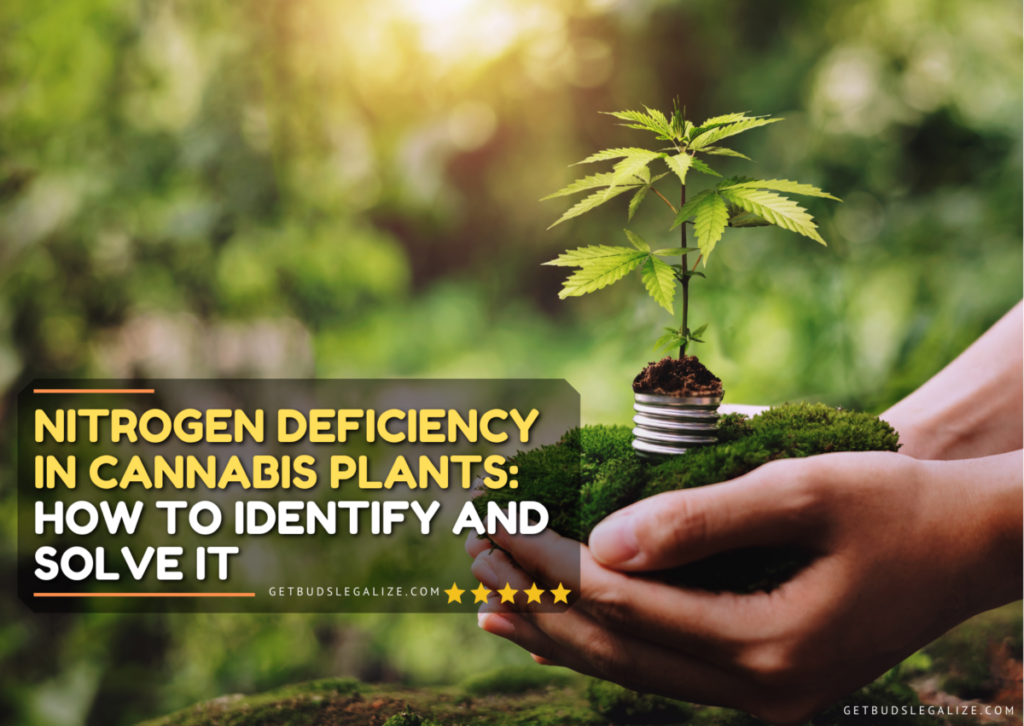Low Stress Training Techniques: How To Get Better Yields From Your Cannabis Plants
If you are growing cannabis indoors, you might be wondering how to maximize your space and get the most out of your plants. One of the best ways to do that is by using a technique called low stress training (LST). LST is a method of manipulating the shape and structure of your plants to increase their light exposure, airflow, and bud production. In this tutorial, we will explain what LST is, how it works, and how to apply it to your cannabis plants.
What Is Low Stress Training LST and How Does It Increase Yields for Cannabis Growers?
LST is a form of plant training that involves gently bending and tying down the branches of your plants to create a more even canopy and expose more bud sites to light.
Unlike other forms of training, such as topping or pruning, LST does not involve cutting or damaging the plant tissue, which can cause stress and slow down growth. LST is considered a low-stress technique because it mimics the natural process of plants growing toward the light source.
By using LST, you can achieve several benefits for your plants:
- More light exposure: By spreading out the branches horizontally, you can create a more uniform canopy that receives more light from your grow lights. This can increase the photosynthesis rate and energy production of your plants, leading to faster growth and bigger buds.
- More airflow: By creating more space between the branches, you can improve the airflow around your plants, which can prevent mold, pests, and diseases. This can also help regulate the temperature and humidity levels in your grow area, which can affect the quality and potency of your buds.
- More bud production: By exposing more bud sites to light, you can stimulate the development of more flowers on your plants. This can increase the yield potential and density of your buds, as well as their resin and terpene production.
How Does Low-Stress Training Work?

LST works by taking advantage of the plant’s natural response to bending. When you bend a branch, you create a slight injury on the stem that triggers a hormone called auxin. Auxin is responsible for regulating plant growth and development, especially in relation to gravity and light.
Auxin normally accumulates on the tip of the branch, which causes it to grow upwards and dominate over the lower branches. This is known as apical dominance.
However, when you bend a branch, you disrupt the auxin flow and distribution on that branch. This causes two things to happen:
- The bent branch will slow down its growth and focus on healing the injury.
- The lower branches will sense less auxin and more light, which will stimulate their growth and make them catch up with the bent branch.
By repeating this process on different branches, you can create a more balanced and horizontal canopy that has multiple main colas instead of one central one. This way, you can make use of all the available space and light in your grow room.
What Are the Most Common Method of LST?
The Screen of Green (ScrOG):
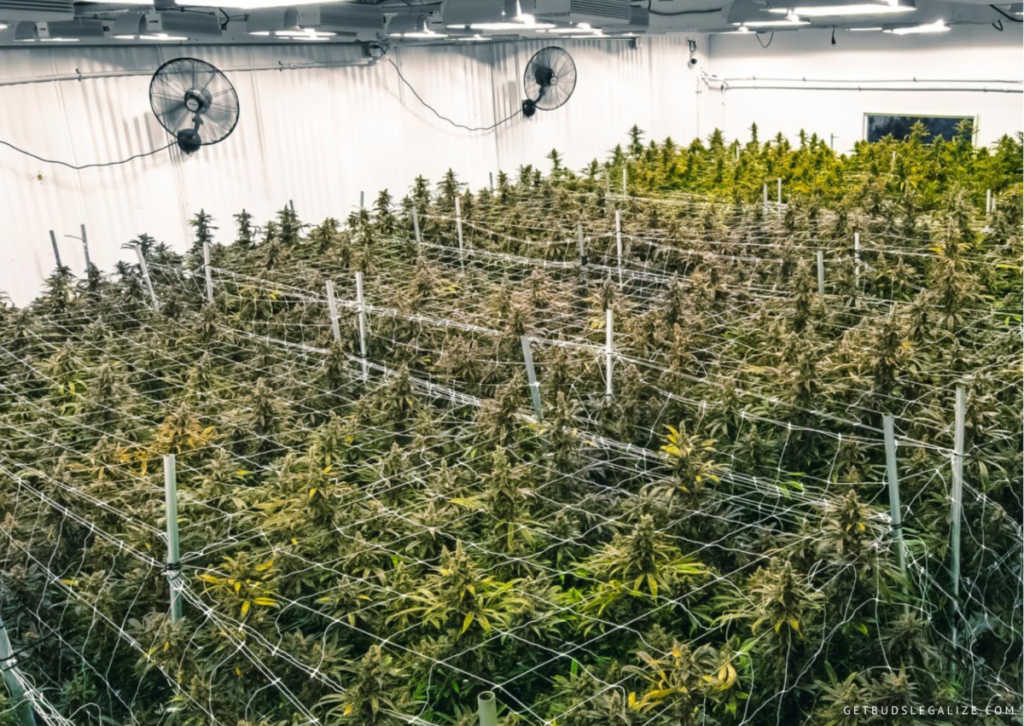
This method involves using a horizontal mesh to train the plants to grow in a flat canopy. This method allows for optimal light exposure and efficient use of space, resulting in bigger yields and better-quality buds.
ScrOG is suitable for indoor and outdoor growers who want to maximize their harvest potential and control the height and shape of their plants. ScrOG requires some skill and patience, as the grower has to carefully prune and tuck the branches under the screen throughout the vegetative and flowering stages.
ScrOG also requires a longer vegetative period than other methods, as the plants need to fill up the screen before switching to flowering. However, the benefits of ScrOG outweigh the drawbacks, as it can produce up to three times more buds per plant than other techniques
Low-Stress Training (LST):
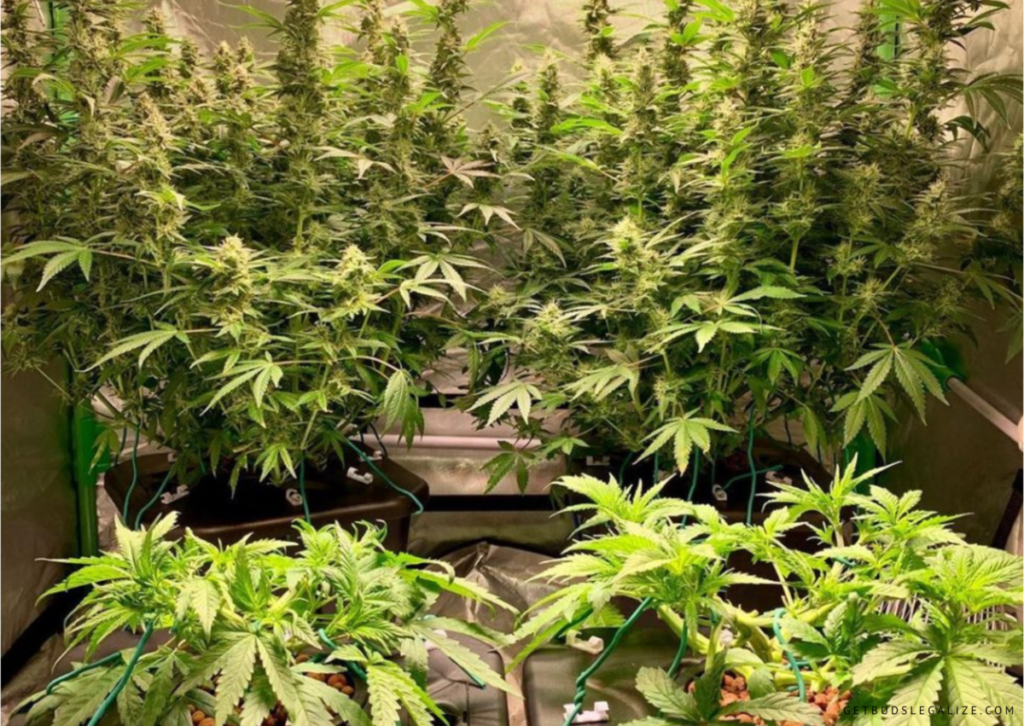
LST is a technique that involves training cannabis by gently bending and securing the stems and branches to manipulate their shape and size.
The purpose of LST is to break the natural tendency of cannabis to grow one main stem with smaller side branches, known as apical dominance. By bending and tying down the main stem, LST creates a more even canopy of buds that receive optimal light exposure and airflow.
This results in higher yields, better quality, and more efficient use of space and resources.
When to Start Low Stress Training?
LST training can be started as soon as the plants have developed 3-4 nodes, which usually happens around 2-3 weeks after germination. However, some growers prefer to wait until the plants have 5-6 nodes or more, which gives them more branches to work with and reduces the risk of snapping the stems.
When to Stop Low Stress Training?
LST can be continued throughout the vegetative stage and into the early flowering stage until the plants stop stretching. This usually happens around 2-3 weeks after switching to a 12/12 light cycle for photoperiod plants, or around 4-5 weeks after germination for autoflowering plants.
After this point, LST should be stopped to avoid damaging the buds and stressing the plants too much. The branches and stems will harden and become less flexible as the buds mature, so any further bending or tying could cause them to break.
The Complete Guide for a Perfect Low Stress Training Step by Step:
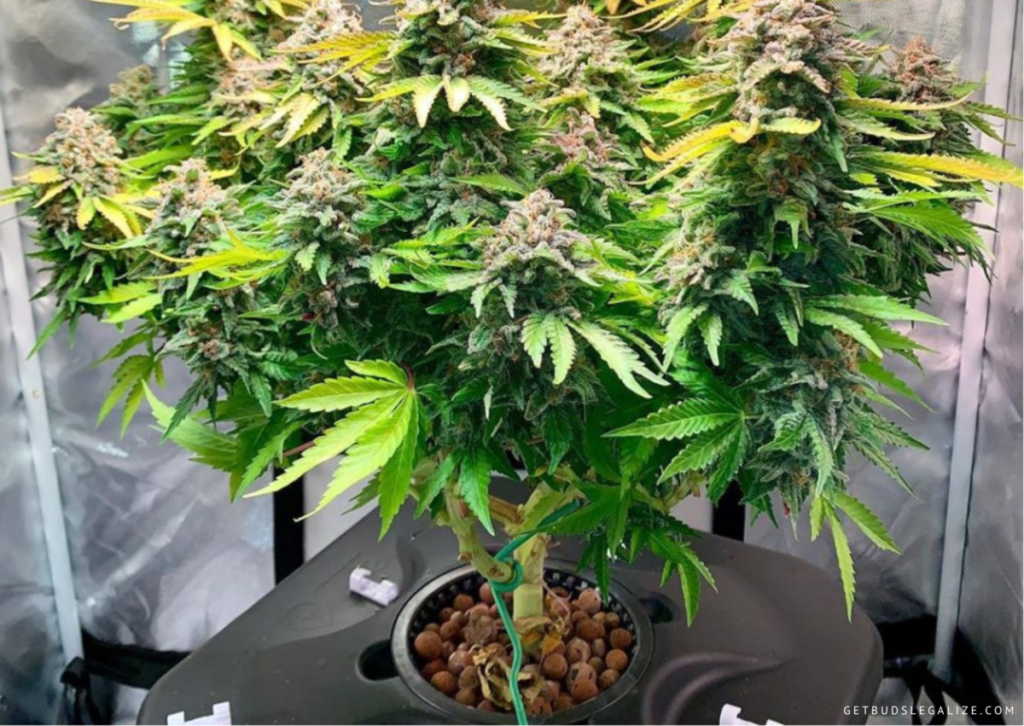
To perform this LST technique on your marijuana plants, you will need some basic low stress training tools, such as:
- Soft plant ties or coated garden wire: These are used to secure the branches of the pot or a support structure. Avoid using anything sharp or rough that could damage the plant tissue.
- A hand drill or a pair of scissors: These are used to make holes around the rim of the pot or to cut the wire.
- A tomato cage or a trellis net: These are optional but can help you create a more even canopy and support the branches.
Here are the steps to follow to achieve a perfect result:
Step 1: Choose the Right Time
The best time to start LST is when your plants have at least 3-4 nodes (sets of leaves) and their stems are flexible enough to bend. This usually happens around 2-3 weeks after germination. You can continue LST until the second week of flowering, but be careful not to stress your plants too much during this stage.
Step 2: Bend the Main Stem
The first step of LST is to bend the main stem of the plant sideways and secure it to the edge of the pot or a support structure. This will break the apical-dominance of your plant and encourage side branch growth. You can use a soft plant tie or coated garden wire to tie the stem gently but firmly. Make sure you don’t damage or break the stem.
Step 3: Bend the Side Branches
The next step is to bend the side branches of your plant in different directions and secure them as well. This will create a more horizontal and flat canopy that will receive more light and produce more buds. You can use the same method as in step 2, but be more gentle with the thinner branches.
Step 4: Monitor and adjust
The last step is to monitor your plants and adjust them as they grow. You may need to reposition some ties or wires or add new ones, to maintain the desired shape and size of your plants. You may also need to prune some leaves or branches that block light or airflow. Be careful not to overdo it, as too much stress can harm your plants.
Step 5: Enjoy your Results
After following these steps, you should see your plants grow larger and bushier, with more bud sites exposed to light. This should result in large plants, higher yields, and better crop quality. Enjoy your LST cannabis plants!
Can You Combine Topping and LST?
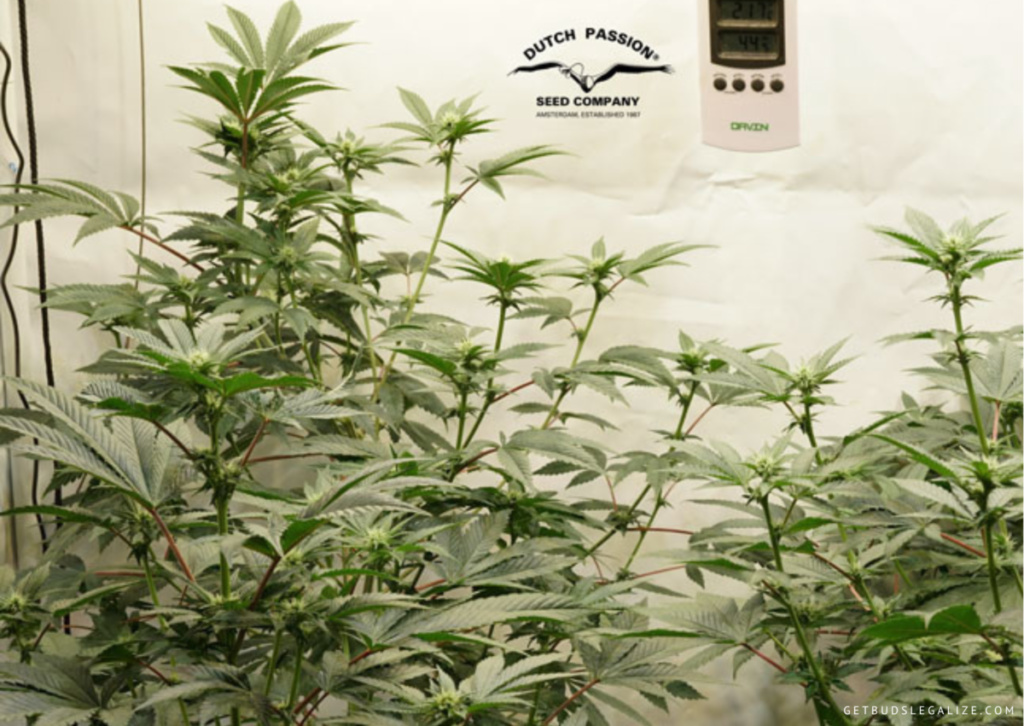
If you are looking for ways to improve your cannabis yield and quality, you might want to consider combining topping and low stress training (LST).
Topping is a high stress training technique that involves cutting off the main stem of a cannabis plant at a certain point, usually above the third or fourth node. This causes the plant to stop growing vertically and instead produce two main colas (flowering branches) from the cut site. Topping also stimulates the growth of the lower branches, creating a bushy and even canopy.
By combining topping and cannabis training, you can create a cannabis plant that has multiple colas, a wide and flat canopy, and optimal light distribution. This can result in higher yields, better quality buds, and more efficient use of space.
However, there are some things to keep in mind when applying these techniques:
- Choose the right strain: Some strains are more suitable for topping and LST than others. Indica-dominant strains tend to have a shorter and bushier growth pattern, which makes them easier to train. Sativa-dominant strains tend to have a taller and lankier growth pattern, which makes them harder to train. However, this also means that sativa strains can benefit more from topping and LST, as they can be controlled and shaped better.
- Choose the right time: Topping and LST should be done during the vegetative stage of the cannabis before it starts flowering. The topping should be done when the plant has at least four nodes, but not too late in the vegetative stage, as this can delay the flowering time. LST can be done throughout the vegetative stage, but it is best to start early when the branches are still flexible and easy to bend.
- Choose the right method: There are different ways to top and LST your cannabis plants, depending on your preference and experience level. For the topping, you can use scissors, a razor blade, or your fingers to cut off the main stem. For LST, you can use string, wire, clips, or stakes to tie down the branches. You can also use a screen or a net (known as SCROG or screen of green) to support and train your branches horizontally.
- Choose the right amount: Topping and LST can be done multiple times on the same plant, depending on how much you want to manipulate its shape and size. However, you should not overdo it, as this can stress out your plant and affect its health and performance. A good rule of thumb is to top your plant once or twice and LST your branches until they fill up your available space.
Topping and LST are two powerful techniques that can enhance your cannabis-growing experience. By combining them, you can create a cannabis plant that is more productive, more potent, and more beautiful. Just remember to do it right and enjoy the results!
Low Stress Training Techniques - FAQs
The LST method for plants is a technique that involves bending and tying the branches of a plant to create a more even and flat canopy. This allows more light to reach the lower buds and increases the overall yield. The LST method is based on an ancient practice of espalier, which is used to shape plants along a flat surface. The LST method is gentle and does not stress the plant too much, unlike other training methods that involve cutting or breaking the branches.
Topping and LST are two methods of training plants to increase their yield and quality. Topping involves cutting off the main stem of the plant, which encourages the growth of multiple colas. LST stands for low stress training, which involves bending and tying down the branches of the plant to create an even canopy and expose more buds to light.
LST in the flowering stage is possible, but not recommended for beginners or inexperienced growers. The best time to start LST is in the vegetative stage when the plant is more resilient and flexible. In the flowering stage, the plant is more sensitive and brittle, and any damage or stress can trigger unwanted responses such as hermaphroditism, stunted growth, or reduced potency.
If you decide to do LST in the flowering stage, you should follow some guidelines to minimize the risk of harming your plant.:
- First, you should only do LST in the early flowering stage, before the buds start to form and swell.
- Second, you should only bend and tie down the branches gently and gradually, avoiding any snapping or breaking.
- Third, you should monitor your plant closely for any signs of stress or damage, and stop LST immediately if you notice any problems.
LST in the flowering stage can be beneficial for some growers who want to improve their yield and quality, but it is not a simple or risk-free technique. It requires skill, patience, and attention to detail. You should only attempt it if you are confident in your abilities and willing to accept the possible consequences.
The answer to the question is yes, you can LST autoflowering strains, but you have to be careful and do it properly. Autoflowering plants are more sensitive to stress than photoperiod plants, and they have less time to recover from any damage.
Therefore, you should only apply LST during the vegetative stage, before the plants start showing signs of flowering. You should also avoid breaking or cutting any branches, as this can trigger a stress response and stunt the growth of the plants. Instead, you should gently bend and secure the branches with soft ties or clips, leaving some slack for them to grow.
Training autoflowers strains can be beneficial, as it can improve the light distribution and airflow in the canopy, resulting in more and bigger buds. However, you should always monitor your plants closely and adjust the ties as needed to avoid any stress or injury.
LST is not a mandatory technique for autoflowering strains, but it can be a useful tool to optimize your grow space and maximize your harvest.



